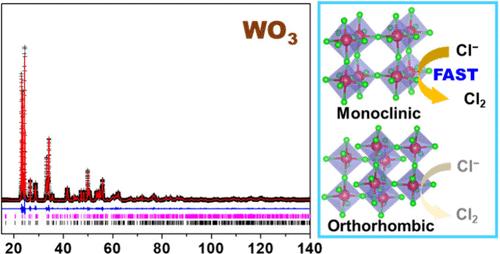优化氯化物光电化学氧化性能的 WO3 阵列热力学和结构分析
IF 8.2
2区 材料科学
Q1 MATERIALS SCIENCE, MULTIDISCIPLINARY
引用次数: 0
摘要
了解 WO3 的晶体结构对于优化其光电化学性能至关重要。本研究全面分析了 WO3 在合成过程中的结构特征,并研究了它们与光电化学活性的相关性。结合退火程序和 WO3 厚度进行的结构分析确定了 WO3 阵列中的六方、单斜和正方相混合。具体来说,详细分析显示,单斜 WO3 相和正交 WO3 相都占主导地位,而这两种相通常都以单斜结构为特征。使用有限元法进行的三维热力学模拟显示,在热诱导合成过程中,WO3 层的热位移随着厚度的增加而增加。这些结果凸显了 WO3 厚度、热位移和相变之间的直接相关性,由于热诱导变形的增加,较厚的 WO3 层有利于从正方晶结构转变为单斜晶结构。单斜结构的对称性比正方体结构低,因此会产生更多的缺陷点,这表明供体密度增加了。值得注意的是,单斜为主的 WO3 在 0.5 M NaCl 紫外可见光照射下表现出卓越的性能。此外,WO3 阵列在氯化物氧化过程中的法拉第效率超过 85%,表明在 0.5 M NaCl 中其选择性优于氧进化反应。这项研究强调了 WO3 晶体结构在实现高效光电化学海水分离中的关键作用。本文章由计算机程序翻译,如有差异,请以英文原文为准。

Thermomechanical and Structural Analysis of WO3 Array for Optimized Photoelectrochemical Chloride Oxidation Performance
Understanding the crystal structure of WO3 is essential for optimizing its photoelectrochemical performance. This study comprehensively analyzes the structural characteristics of WO3 during synthesis and investigates their correlation with photoelectrochemical activity. Structural analysis, incorporating annealing procedure and WO3 thickness, identifies a blend of hexagonal, monoclinic, and orthorhombic phases within WO3 array. Specifically, detailed analysis reveals a predominance of monoclinic WO3 phase alongside the orthorhombic WO3 phase, both of which are commonly characterized by their monoclinic structure. Three-dimensional thermomechanical simulations using the finite element method reveal that thermal displacement in WO3 layers increases with thickness during the thermally induced synthesis process. These results highlight a direct correlation between WO3 thickness, thermal displacement, and phase transition, with thicker layers favoring the transformation from orthorhombic to monoclinic structures due to increased thermally induced deformation. The heightened monoclinic structure, which possesses lower symmetry than the orthorhombic structure, induces more defect sites, suggesting increased donor density. Notably, the monoclinic-dominated WO3 exhibits superior performance under UV–visible irradiation in 0.5 M NaCl. Furthermore, the WO3 array demonstrates over 85% Faradaic efficiency for chloride oxidation, indicating preferential selectivity over oxygen evolution reaction in 0.5 M NaCl. This study emphasizes the pivotal role of the crystal structure of WO3 in achieving efficient photoelectrochemical seawater splitting.
求助全文
通过发布文献求助,成功后即可免费获取论文全文。
去求助
来源期刊

ACS Applied Materials & Interfaces
工程技术-材料科学:综合
CiteScore
16.00
自引率
6.30%
发文量
4978
审稿时长
1.8 months
期刊介绍:
ACS Applied Materials & Interfaces is a leading interdisciplinary journal that brings together chemists, engineers, physicists, and biologists to explore the development and utilization of newly-discovered materials and interfacial processes for specific applications. Our journal has experienced remarkable growth since its establishment in 2009, both in terms of the number of articles published and the impact of the research showcased. We are proud to foster a truly global community, with the majority of published articles originating from outside the United States, reflecting the rapid growth of applied research worldwide.
 求助内容:
求助内容: 应助结果提醒方式:
应助结果提醒方式:


